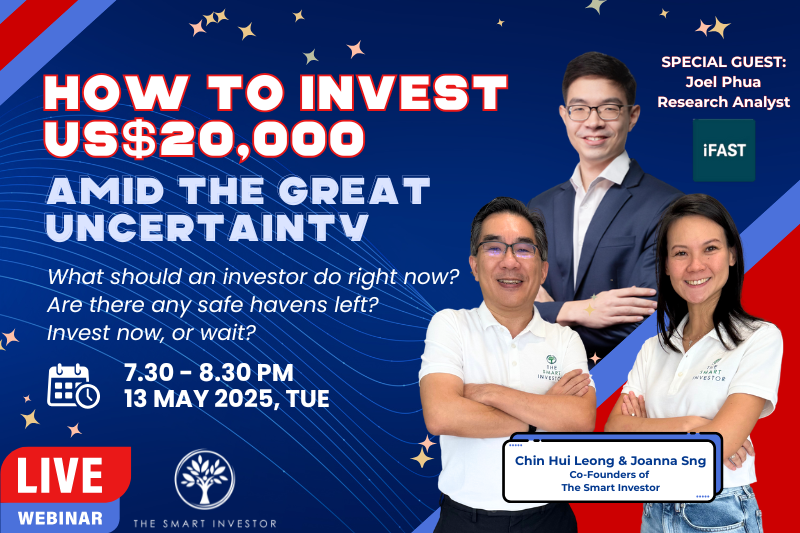REITs have been reliable vehicles for income-seeking investors.
A REIT must pay out at least 90% of its taxable income in the form of dividends.
Because of this, REITs are widely recognised as dependable and consistent sources of passive income.
There are caveats, though.
Some REITs may stumble due to crises such as the COVID-19 pandemic, while others may see their distribution per unit (DPU) stagnating because of a lack of growth options.
As an income investor, an important trait is the sustainability of the dividend payouts.
Good REITs are also able to increase their DPU gradually over time through a variety of methods.
Here are five signs you can look for to tell you if a REIT can pay you for life.
1) A strong sponsor
Most REITs will have a sponsor.
A sponsor usually provides financial backing for the REIT and may also be a major unitholder in it.
Sponsors may also have a ready pipeline of properties that they can inject into the REIT, helping it to grow over time.
Strong sponsors can help the REIT borrow at lower rates and can also support the REIT’s growth over time.
Some examples of good sponsors are CapitaLand Limited (SGX: C31), Frasers Property Limited (SGX: TQ5) and Mapletree Investments Pte Ltd.
Each of these sponsors has a variety of REITs under its management and has helped them to grow successfully over time.
2) High occupancy rates
Occupancy rate represents the proportion of a REIT’s properties that have been rented out.
A high occupancy rate means that the REIT manager is maximising the REIT’s rental income by keeping vacancy rates low.
Investors should observe the REIT’s occupancy rate trends over some time to assess if they are consistently high.
A REIT with quality clients stands a better chance of maintaining high occupancy even during crises.
A good example of a REIT with a high occupancy rate is Mapletree Commercial Trust (SGX: N2IU).
As of 31 December 2020, the REIT’s committed occupancy stood at 98.1%.
3) Long weighted average lease expiry (WALE)
A REIT’s WALE, measures the average length of leases for its tenants.
As leases expire, the REIT manager will have to engage its existing tenants to renew their leases.
If economic conditions are poor, some tenants may choose to not renew their leases or try to negotiate for lower rental rates.
Hence, if a REIT can lock in a tenant for a longer period, it also provides more certainty on rental income flow.
REITs that have a long WALE provide unitholders with the assurance on the continuity of the rental income, as leases do not have to be renegotiated so often.
An example of a REIT that has a relatively long WALE is Keppel DC REIT (SGX: AJBU).
As of 31 December 2020, the REIT’s WALE was 6.8 years for its portfolio of data centres.
4) Low to moderate leverage
REITs are leveraged instruments that rely heavily on debt to operate and acquire.
The Monetary Authority of Singapore (MAS) mandates that the maximum gearing allowed for a REIT is 45%.
Because of the pandemic, MAS has raised this limit to 50% to give more breathing room for REITs.
For REITs to have room to grow DPU, their gearing level should not be excessively high.
Having a high gearing level stunts the growth of the REIT and may lead to a dilutive rights issue as the REIT will need to tap on equity to raise funds and bring down its leverage.
Mapletree Industrial Trust (SGX: ME8U) has a gearing level of 37.3% as of 31 December 2020 that is comfortably within MAS’ threshold.
5) Track record of growing DPU
Finally, a REIT should also have a strong track record of growing its DPU.
By doing so, investors gain assurance that the REIT has what it takes to continue its healthy run.
As sustainability is a key focus as to whether a REIT can pay you for life, you should observe the reasons for the growth in DPU over time.
A combination of organic growth, rental reversions and acquisitions can power DPU growth for strong REITs, making them ideal targets for long-term ownership.
Take Parkway Life REIT (SGX: C2PU) for instance.
The healthcare REIT has demonstrated uninterrupted DPU growth since 2008, despite the REIT going through two major crises.
DPU has grown from S$0.0683 in 2008 to S$0.1379 in 2020.
A secure, worry-free retirement may not be as far-fetched as you may believe. In our latest special FREE report, we cover eight stocks, consisting of a mix of blue-chips and mid-cap companies, that we believe can ride the recovery and offer investors a great mix of both growth and income. Click HERE to download the report, 8 Singapore Stocks for Your Retirement Portfolio, for FREE now!
Follow us on Facebook and Telegram for the latest investing news and analyses!
Disclaimer: Royston Yang owns shares in Keppel DC REIT.




